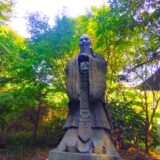【Nihonbashi Bridge summary】
Nihonbashi Bridge, built by the Edo Shogunate, is the hub of the Five Routes and one of the most important transportation hubs in Japan. The first Nihonbashi Bridge was built in 1603 (Keicho 8). At that time, it was a wooden drum bridge, and the current Renaissance-style stone double arch bridge was built in 1911 and is a National Important Cultural Property. The bridge spans the Nihonbashi River, hence the name of the area.
![Nihonbashi Bridge [Tokyo] DSC 0532 1024x768 - Nihonbashi Bridge [Tokyo]](https://japan-shrine.info/wp-content/uploads/DSC_0532-1024x768.jpg)
The winged kylin statues symmetrically arranged around the decorative columns of the flower-shaped lamps are very famous.
![Nihonbashi Bridge [Tokyo] 3895819 m 683x1024 - Nihonbashi Bridge [Tokyo]](https://japan-shrine.info/wp-content/uploads/3895819_m-683x1024.jpg)
The two entrances are flanked by “lions” and the center by a “kylin” statue. The inscription “Nihonbashi” is in the handwriting of the last Tokugawa Shogun, Prince Keiki. Just to be clear, there is another nameplate above the Nihonbashi, but this one is for the Metropolitan Expressway Inner Circular Route.
![Nihonbashi Bridge [Tokyo] DSC 0535 2 1024x768 - Nihonbashi Bridge [Tokyo]](https://japan-shrine.info/wp-content/uploads/DSC_0535-2-1024x768.jpg)
The main Mitsukoshi department store, established in 1904, is located nearby, making it a good place to stroll around and enjoy the atmosphere of the town.
【Nihonbashi Bridge Nearby attractions】
Fukutoku Shrine (Meibuki Inari), Mitsukoshi Main Store
【Nihonbashi Bridge Access】
Manager’s Comments
Currently, the elevated bridge over the Nihonbashi Bridge is a disappointment in terms of scenery due to the Metropolitan Expressway Inner Circular Route, but underground construction is underway, so the original Nihonbashi will be visible around 2040. To be honest, the bridge is not much of a tourist attraction, so it would be better to combine sightseeing with a tour of the city where Meiji-era buildings still remain.
1-8 Nihonbashi Muromachi, Chuo-ku, Tokyo – 1-1 Nihonbashi
※No parking is available.
 Tour of Japanese shrines and temples
Tour of Japanese shrines and temples 

![Nihonbashi Bridge [Tokyo] DSC 0542 520x300 - Nihonbashi Bridge [Tokyo]](https://japan-shrine.info/wp-content/uploads/DSC_0542-520x300.jpg)
![Nihonbashi Bridge [Tokyo] DSC 0542 150x150 - Nihonbashi Bridge [Tokyo]](https://japan-shrine.info/wp-content/uploads/DSC_0542-150x150.jpg)
![Nihonbashi Bridge [Tokyo] DSC 0851 2 150x150 - Nihonbashi Bridge [Tokyo]](https://japan-shrine.info/wp-content/uploads/DSC_0851_2-150x150.jpg)
![Nihonbashi Bridge [Tokyo] DSC 1773 150x150 - Nihonbashi Bridge [Tokyo]](https://japan-shrine.info/wp-content/uploads/DSC_1773-150x150.jpg)
![Nihonbashi Bridge [Tokyo] DSC 1145 1 150x150 - Nihonbashi Bridge [Tokyo]](https://japan-shrine.info/wp-content/uploads/DSC_1145-1-150x150.jpg)

